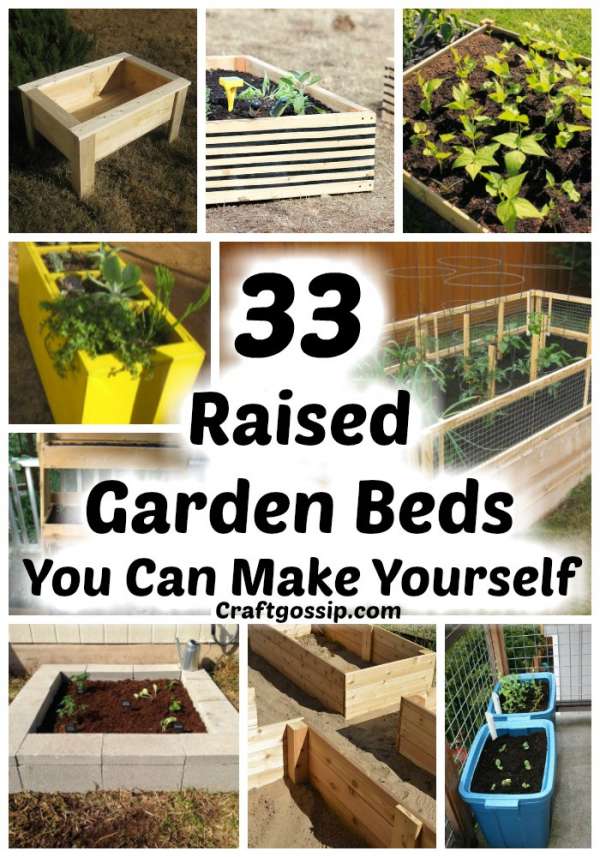
What is a Raised Garden Bed? It is a large planting container that sits above the ground and is filled with soil.
So why are raised garden beds so popular? The Urban Farmer! Suddenly we are all faced with a shortage of supplies and it has made many of us go back to basics with growing and providing for our own basic food needs, instead of relying on big supermarket chains. Suddenly we need to grow our own food.
Personally I love that the soil is poured into the raised garden bed and not dug up. Me and Shovels or spades just don’t go together. Digging a garden bed out is far harder than one can imagine. Now, pouring the potting mix
into a barrel or box appeals to my not-so-green thumb much more. My homemade raised garden beds are also high enough so that I do not need to bend down due to back issues. So raised beds are great for the elderly and frail too, it allows them to keep gardening for many more years.
DIY Raised or potted garden beds are perfect for small areas, uneven gardens and those who may need to up and move. Raised garden beds can be placed on any surface including a deck, concrete and heavy clay soils or soils that are too acidic for growth.
Garden beds allow you to be organized and contain your way to grow vegetables.
Growing food in raised garden beds provides an extra layer of defence against pests and bugs too. You may have pets that like to dig and need to raise your garden bed away from little paws.
Of course there are literally 100’s of different ways to make your own garden beds and in this roundup, we have included 33 variations of making your own. Some of these tutorials use containers, recycled pallet wood, new wood, steel and you can even make them from fabric raised garden beds.
If you make your own Raised garden bed please pop back and share a photo and tell us what you planted. I have started with some Rosemary and Basil
in mine Because apparently they are hard to kill.
How to Build a Raised Bed for Growing a Garden | Better Homes & Gardens
Raised Garden Bed: Easy DIY Steps to Build an Elevated Planter – Sunset
How To Build a Raised Garden Bed
DIY Raised Bed Planter : 16 Steps (with Pictures)
DIY Tiered Herb Garden Tutorial — Decor and the Dog
How To Build An Elevated Garden – Addicted 2 Decorating®
https://cloverandthyme.com/2013/04/01/diy-garden-enclosure/
Raised Plastic Barrel Planter Tutorial
Building a Raised Bed Garden Frame with Benches
DIY Raised Garden Bed With Landscaping Timbers
How to Build a Raised Garden Bed for Vegetables
How to Build a Raised Multi-Leveled Garden Planter Box – Growing The Home Garden
DIY Cinder Block Raised Garden Bed
DIY Starter Raised Bed for Kids – FineGardening
Building a Raised Bed Garden Frame with Benches
How To Build A Raised Metal Garden Bed
Lemon, Bean and Things: Recycle Tire Planter – Under $80.00
DIY Cinder Block Raised Garden Bed
Cinderblock raised beds – let’s talk about this
Build a Concrete Block Garden for Food and Memories
Bonnie Plants – Garden Plants for Your Vegetable Garden or Herb Garden
DIY Raised Garden Beds with Corrugated Metal
The great crate garden | Tiny House Toronto
DIY Raised Bed (Removable) Pest Gate – FineGardening
How to Build an A-Frame Garden Trellis
How to DIY build a tall garden planter for vegetables and easy weeding
Did you know Raised garden beds allow you to plant earlier than usual – The soil in raised garden beds is warmer than the earth’s soil at ground level.
Growing blueberries is different than growing huckleberries, though the plants are so similar. Both are worthwhile to grow. The person who successfully grows huckleberries is actually the lucky one, as they are the more difficult to grow. Blueberries and huckleberries are quite similar in many ways. The bushes and even the berries look alike, they have the same requirements for growth, and they both prefer acidic soil. However, growing them in the garden isn’t the same between two.
The preparation of the soil for the two berries is similar. This begins with digging a good-sized hole, about 3 feet (1 meter) deep. In the hole, add good quality finished compost, to furnish the bushes with food. This also lets the soil drain more readily.
Since the bushes prefer acidic soil, it is a good idea to add substances that will lower the pH of the soil, such as pine needles. Fish or fish fertilizer, including homemade fish fertilizer, is an excellent addition as well. This gives the bushes an added boost of energy.
With rich soil to grow in, including compost and fish, the bushes will have enough food to get them growing well. However, there is a difference between huckleberries and blueberries even here. Blueberries generally require more room for both the bushes and root structure to grow. This means that the hole for the blueberries should be about 3 feet in diameter, while huckleberries will grow well in a hole only 2 feet in diameter.
The development of smaller, denser fruit and vegetable plants, has allowed container gardeners to experience the pleasure of growing homegrown food. These plants, known as dwarf plants, can be grown on porches, balconies, patios, and other small areas. Having little space for a proper garden is no longer inhibitive to food growth.
Several varieties of dwarf blueberry plants are available and work very well when grown in pots. They produce well, and can produce up to ten pounds of fruit once matured.
Blueberry Sunshine Blue is a semi-dwarf plant. They grow up to four feet tall. Hot pink flowers are produced in May, and blueberries ripen through July and August. They produce a lot of fruit.
Tophat blueberry plants are popular in containers. They are smaller than the Sunshine Blue, growing to a height of about eighteen inches. They produce fruit throughout the summer.
In cooler climates, the Dwarf Northsky is ideal. Reaching about eighteen inches in height, the plants form an attractive mound shape. White flowers bloom, followed by ripened fruit in July. The leaves of this plant turn a lovely red color in autumn. The antioxidant levels are higher in these berries than in those of the Tophat.
The Bluecrop variety is drought resistant, and therefore a little more forgiving to those people who sometimes forget to water. This one produces well, and can tolerate cooler temperatures. Fruit is ready in July.
In general, blueberry plants are quite easy to care for when grown in pots. They like well-drained soil that holds moisture. Peat moss will work just fine. They also like decomposing compost, so add grass clippings, manure, or compost to the soil.
Plant in a good-sized container, as these plants, spread. Use a two-gallon pot for the smaller dwarfs, much larger for the semi-dwarfs such as the Blueberry Sunshine Blue. Check the plants for dryness often. Ammonium sulfate fertilizer twice during the growing season is sufficient. They like full sun.
Dwarf Blueberry plants are most easily found in mail-order nurseries, although some larger garden centers will carry them. Blueberries are high in antioxidants, the plants are attractive, and will be a worthwhile addition to any container garden. Below is an easy recipe to help you enjoy your harvest.
Strawberries are a wonderfully sweet fruit that can be grown in your container garden. Your strawberries will grow best in full sunlight. There are many different types of strawberries for you to try growing in your own garden.
Growing strawberries in a garden or even a flowerbed is another way to enjoy this fruit. Strawberries grow in just about any soil but do best in highly fertile soils. They require about six hours of full sun a day. Plant the strawberries away from other taller plants to avoid too much shade during the day.
Plant the strawberries in rows, about twenty-four inches apart and make each row about three to four feet apart. They should not be planted in an area that was previously used to grow tomatoes, peppers, eggplant or potatoes. These plants can carry a disease called Verticillium Rot, which can be hazardous to the strawberry plants. If rain has not fallen in a week, give the plants about one to two inches of water.
Growing Strawberries
Pick a pot that is at least 24 inches tall so your plants have room to grow. It is best to grow ever-bearing strawberries so you have a crop to eat all summer long. Fill your container with soil such as an organic potting mix. You may want to use hanging basket-style planters for strawberries that can be found on the market but an ordinary planter will do fine.
Be sure the pot has adequate drainage for water. It is best to start with young seedlings or established plants and not seeds that will take too long to grow. If you have large pot you can put more than one plant inside it but if the pot is smaller use only one plant so the strawberries can get enough sunlight for adequate growth. You can even grow them inside if they get enough sunlight.
Give the plants a good watering but don’t overwater the plants and soak them so there is water standing around in pools. Use a high phosphorus liquid fertilizer every week to encourage the plants to flower and start bearing fruit.
Rotate the plants as they grow so the plants get adequate sunlight on all sides. Aphids and spider mites can be a problem for strawberries so use an insecticide soap on them to treat the infestations. You can make homemade soap by using one part soap and 15 parts water which should kill the pests. If they continue to be a problem ask your local garden center for help.
Harvest your strawberries once they are red and fully ripe. Once they produce fruit the plant will put out runners, which you can stick in the pot to grow a new plant or clip them off. They can be eaten fresh or frozen for later use. If you are freezing them, arrange the berries on trays and freeze them in the freezer before putting them in bags. This will keep the berries from sticking together and make them easier to use when you are ready to consume them. Fresh berries should be eaten within a week before they start to spoil.
Growing strawberries can provide you with a healthy delicious fruit to enjoy during the summer. Be sure your plants get lots of sunlight and don’t over water them. Enjoy the fruit fresh or freeze the berries so you have fruit to enjoy during the cold winter months.
Whether choosing to grow strawberries in a pot or in the garden growing them can be a satisfying and tasty experience. Strawberries make delicious desserts, jams and fruit salads. Kids usually enjoy eating them right out of a bowl. Consider planting some strawberries this year. It is a great way to enjoy this fruit and will brings months of enjoyable eating.
Homesteading is a lifestyle characterized by self-sufficiency, sustainability, and a focus on living off the land. Historically, homesteading referred to the process of settling and developing land for agricultural purposes, often through government programs that provided land grants to settlers. Today, homesteading encompasses a broader range of practices, including gardening, raising livestock, preserving food, and reducing reliance on modern conveniences.
Homesteading has become increasingly popular in recent years for several reasons:
- Desire for Self-Sufficiency: Many people are drawn to homesteading as a way to reduce their dependence on external sources for food, energy, and other necessities. By growing their own food, raising animals, and generating renewable energy, homesteaders can become more self-reliant and resilient in the face of economic uncertainty or disruptions to supply chains.
- Focus on Sustainability: Homesteading promotes sustainable living practices that minimize environmental impact and conserve natural resources. By producing food locally, using renewable energy sources, and implementing conservation techniques, homesteaders can reduce their carbon footprint and contribute to a healthier planet.
- Health and Wellness: Growing concerns about the quality and safety of commercially produced food have led many people to seek out alternatives such as organic gardening and pasture-raised livestock. Homesteading allows individuals to have greater control over the quality and freshness of their food, leading to improved health and well-being.
- Escape from Urban Life: The hustle and bustle of city living can be overwhelming for some people, leading them to seek out a simpler, more peaceful way of life in rural or semi-rural areas. Homesteading offers an opportunity to reconnect with nature, enjoy a slower pace of life, and find fulfillment in manual labor and outdoor activities.
- Financial Considerations: Rising costs of living, housing, and utilities in urban areas have prompted some individuals and families to explore homesteading as a more affordable alternative. By reducing expenses associated with food, housing, and transportation, homesteaders can achieve greater financial freedom and stability.
Overall, homesteading appeals to a diverse range of individuals and families seeking a more sustainable, self-sufficient, and fulfilling way of life in harmony with nature.




